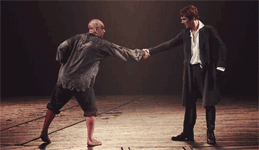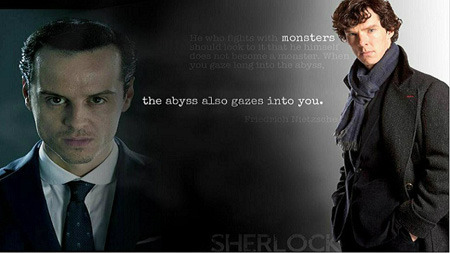Posted by Sherlock Holmes  October 9, 2012 11:32 pm | #21 |
Mattlocked wrote:
kazza474 wrote:
....
The chances that guy learned the skills to getting it to return straight to him are pretty small, going on personal experience.
And that's exactly the reason why!
That guy tried and tried without any effort so he wouldn't think for a second that it might return this time!
Ahh indeed! That's why he wasn't paying attention!
---------------------------------------------------------------------------------------------------------------------------------------------
Eventually everyone will support Johnlock.
Independent OSAJ Affiliate

Posted by tiharoa  October 16, 2012 7:14 pm | #22 |
kazza474 wrote:
SusiGo wrote:
Oh, I am ashamed. Even a German like me could have remembered the boomerang. But I must admit, I still don't see the error. (five minutes later) Well, I now I've read something about boomerangs. There a returning and non-returning ones. Fine. Could it be that the boomerang shown in ASiB is a non-returning one?
The other thing I would say is those markings don't look very Aboriginal to me.
A friend brought me back from Australia a boomerang exactly like this (Chinese I'm sure). ![]() But now I recovered it from the Hideous Presents Box and it's on display as Murder Weapon
But now I recovered it from the Hideous Presents Box and it's on display as Murder Weapon ![]()
------------------------------------------------------------------------------------------------------------------------------------------------------------------------------------------------------------------------
Valentine: Do you know the stars, Mr Tietjens?
Christopher: I despise astronomy.

Posted by Wholocked  October 17, 2012 12:20 am | #23 |
Not only is it extremely unlikely to have returned; it's virtually impossible that it would have returned directly to him. Boomerangs are incredibly difficult to master; very few people can actually use them properly and as Kazza has said, a tourist is unlikely to have learned how ![]()
Besides; the other thing Sherlock uses to deduce that it's a boomerang is that he's an "avid sports enthusiast". Boomerang throwing isn't a sport - it's a hunting weapon!
-------------------------------------------------------------------------------------------------------------
I dislike being outnumbered. It makes for too much stupid in the room

Posted by besleybean  October 17, 2012 6:16 am | #24 |
Well in it's natural setting a boomerang is a hunting weapon, but there is nothing stopping a sportsman adapting it to his needs.
Plus, this is the movies!
---------------------------------------------------------------------------------------------------------------------------------------------------------------
http://professorfangirl.tumblr.com/post/105838327464/heres-an-outtake-of-mark-gatiss-on-the
Posted by The Doctor  October 17, 2012 9:32 am | #25 |
My 2 cents from making boomerangs for a while, and yes, getting them to return too:
This boomerang is a quite cheap make but looks capable of returning.
The drawing is 'fake Aboriginal' and can be found all over souvenir shops here down under.
Authentic designs come with an explanation of the regional make/artist etc.
If you'd like to learn more see http://www.aboriginalculture.com.au/introduction.shtml
Posted by koilid  November 2, 2012 10:11 am | #26 |
Playing Boomerang is actually also a sport. I used to do it when I was in high school. Look it up in wikipedia, if you want to know more.
In general there are two types of boomerangs as already said.
Ones that can be thrown straight forward and through the rotation they are not droping down. Hunting boomerangs from old poland or australia are mostly from this type.
This ownes can probably kill an animal or human, more likely to knock it out.
The other owns that are used are returning boomerangs. I know the sports type of them.
They are fast, are returning, preatty easily if you build the right shape. Most of them are build for a 20m range, and a flight duration of maybe 3-5 seconds. And they are to light to hurt anybody seriously.
Nevertheless this boomerang for me don't look like it will return. The angle between the two wings is really to big.
Posted by Davina  November 2, 2012 10:54 am | #27 |
Interesting post. They probably just used any old boomerang for the show. I didn't know they had them in old Poland. Another German on the forum and from the former DDR yes. ![]()
![]()
---------------------------------------------------------------------------------------------------------------------------------------------
Don't make people into heroes John. Heroes don't exist and if they did I wouldn't be one of them.

Posted by The Doctor  November 4, 2012 11:38 am | #28 |
koilid wrote:
The angle between the two wings is really to big.
The crucial factor in settling this question would focus on the steepness of the wing shape - I cannot really establish this though it is easy in unpainted boomerangs that reveal their layers, thus revealing their sharp angle on the wing tips. How does this determine flight characteristics?
I am quoting:
Whichever wing is at the top of the spin at any one time ends up moving in the same direction as the forward motion of the throw, while whichever wing is at the bottom of the spin is moving in the opposite direction of the throw. This means that while the wing at the top is spinning at the same speed as the wing at the bottom, it is actually moving through the air at a higher rate of speed.
AND
A boomerang is an aerodynamically shaped object designed to fly efficiently through the air when thrown by hand. The term usually refers to an object made to follow a circular flight path that returns it to the thrower. (Some sources describe all aerodynamic "throwing sticks" as boomerangs, separating them into "returning" and "nonreturning" categories.) Traditional designs are V-shaped, but newer versions may have irregular shapes or more than two arms.
Two design components give the boomerang the capability of circular flight. One is the arrangement of the arms, and the other is the airfoil profile shape that allows the arms into wings. During flight, the boomerang spins rapidly (about 10 revolutions per second). The wing profiles create the same lift effect that makes airplanes fly. In addition, the spinning motion creates gyroscopic precession, which pulls the boomerang into a circular path. A similar effect can be seen with a spinning top: if the top's axis is not quite vertical, the upper portion of the toy travels in a circle around the axis.
For a successful flight, the boomerang must also be thrown correctly. It should be held near the end of one wing with the top (curved) surface facing the thrower's body. The boomerang should be almost vertical, with the thrower holding the lowest arm. Depending on wind conditions and the design of the particular boomerang, the upper portion may be inclined up to 30° outward. After drawing the arm backward, the thrower hurls the boomerang with an overhand motion, much as a pitcher would throw a baseball. At the moment of release, the thrower adds a snap of the wrist, as if cracking a whip. The release angle should be between horizontal and 15° above. If there is any breeze, the boomerang must be thrown between 30° and 90° to the right of the on-coming wind (or to the left for a left-handed thrower; right-and left-handed boomerangs are mirror images of each other).
As the boomerang flies forward, it begins to slowly roll over (counterclockwise for a right-hander), ultimately flying horizontally with its flat side down. When it returns to the thrower, it is caught safely at chest height, trapping it between open hands in a sandwich fashion.
Recreational throwers simply enjoy playing a solitaire game of catch. Those who are interested in competition can choose from a variety of events, including precision (returning as close as possible to the launch point) and endurance (making the most catches in a five-minute period). The inter-national record for distance traveled before returning to the thrower is 780 ft (238 m), in a flight that lasted nearly 22 seconds. The record for maximum time aloft (MTA) is two minutes, 59.94 seconds; the unofficial MTA record, which was witnessed but not thrown in a sanctioned competition, is an astounding 17 minutes, six seconds.
Posted by koilid  November 4, 2012 10:13 pm | #29 |
The profile can not be seen as the boomerang is painted and we only can see a part of it, that doesn't need a big profile at the middle of the angle.
I read again an article my teacher published about boomerangs (it's in german so i can't quote.)
Boomerangs that are returning for a need of physics can not be more than 200g and this light boomerangs don't make good hunting weapons as they are too light to knock people or animals out.
"Non-returning boomerangs (termed "throwsticks" or kylie) for hunting larger prey, such as kangaroo, were used for small prey as well. These throwsticks fly in a nearly straight path when thrown horizontally and are heavy enough to take down a kangaroo on impact to the legs or knees. For hunting emu, the throwstick is aimed toward the bird's neck, in an attempt to break it."
Posted by besleybean  November 5, 2012 7:20 am | #30 |
Isn't it staggering the little details we focus on?
---------------------------------------------------------------------------------------------------------------------------------------------------------------
http://professorfangirl.tumblr.com/post/105838327464/heres-an-outtake-of-mark-gatiss-on-the
Posted by The Doctor  November 7, 2012 1:42 pm | #31 |
koilid wrote:
I read again an article my teacher published about boomerangs (it's in german so i can't quote.) "
Ah, do not underestimate a determined Sherlockian. Feel free to post the quote(s)!
Posted by Mrs. Watson  August 14, 2013 6:55 pm | #32 |
If we've agreed to believe that they always have good reception for the mobile phones and that John's wireless connection in the middle of nowhere allowed him an unfrozen HD video stream... then we can agree to belive that the boomerang returned ![]()
Posted by Mary Me  August 14, 2013 9:53 pm | #33 |
Just came to my mind... that guy was a sportsman after all, would he settle for a typical boomerang sold to tourists? Maybe he got it from a friend who is also into sports... or I'm just missing something at the moment... pretty tired. *yawwn*
~~~~~~~~~~~~~~~~~~~~~~~~~~~~~~~~~~~~~~~~~~
"Falling is just like flying, except there’s a more permanent destination."
"Sherlock Holmes is a great man, and I think one day—if we’re very very lucky—he might even be a good one."
"Would you like to-"
"-have dinner?"
"-solve crimes?"
"Oh"

Posted by sj4iy  August 14, 2013 10:27 pm | #34 |
Mary Me wrote:
Just came to my mind... that guy was a sportsman after all, would he settle for a typical boomerang sold to tourists? Maybe he got it from a friend who is also into sports... or I'm just missing something at the moment... pretty tired. *yawwn*
Almost all boomerangs are made for tourists these days. Very few people actually use them for their intended purpose.
I have a bullroarer that my friends in Tasmania gave me as a present. I've not used it yet.
Last edited by sj4iy (August 14, 2013 10:28 pm)
__________________________________________________________________Bigby: Will you shut up?
Colin: Well, maybe if my throat wasn’t so parched, I wouldn’t have to keep talking.
Bigby: Wait, that doesn’t make se-
Coline: Just give me a drink, please.
Posted by Arabella Trefoil  April 15, 2014 6:24 pm | #35 |
Oh dear. I've always been so fond of Aussies. Now it appears that aren't that matey, down to earth fun people. (Please forgive me if I have used the terms incorrectly. I am a Yank.)
So do Aussies sell clueless tourists fake boomerangs? Do Ausssies, for a laugh, now and then deliberately sell clueless tourists a killer boomerang?
I could understand selling an annoying American tourist a faulty boomerang. I mean, Iive in this country and I know how annoying we can be.
Sorry, I'm a bit thick.
Posted by besleybean  April 15, 2014 6:52 pm | #36 |
I don't think the writers were expecting viewers to be boomerang experts.
I believe it is supposed to be a proper boomerang.
It hit the guy cos he looked away, distracted by the car backfire.
Last edited by besleybean (April 15, 2014 7:28 pm)
---------------------------------------------------------------------------------------------------------------------------------------------------------------
http://professorfangirl.tumblr.com/post/105838327464/heres-an-outtake-of-mark-gatiss-on-the
Posted by Arabella Trefoil  April 15, 2014 7:11 pm | #37 |
I'm new here and still learning how to read the room. I'm married to a Railroad Historian who actually restores old trains.(Real locos, he scoffs at models as a defective subspieces of rail fans.) He and little sewing circle of RR enthusiasts can go berserk about every tiny little detail on any train featured on telly or cinema. They can get into fights over paint colours, uphosltery, signals, dead flies, you name it. Most of the time the art director makes a decision based on what's aesthetically pleasing. Some film production companies do strive for accuracy and go to great lengths to use authentic period locomotives. But it is never ever enough for these rail fans.
I just realized I've been married to a guy with Aspergers for 32 years. I can't even watch my beloved Sherlock DVD's with him because he'd go ballistic at the way the RR security guard was portrayed.
It's just a movie, OK? No more humming, you.
Posted by belis  April 15, 2014 7:22 pm | #38 |
I think when you are an 'expert' in anything be it through work or a hobby it can be very striking when some factual inaccuracies occour. I tend to suspend my disbelief and avoid going on and on about medical errors becouse my family and friends are not that intrested. I do sometimes need to bite my tongue though as my first instinct is to shout 'that's not the way to do it'.
Posted by besleybean  April 15, 2014 7:30 pm | #39 |
Factual details aren''t always important,,,
But I get cross when they get basic 1st Aid wrong!
---------------------------------------------------------------------------------------------------------------------------------------------------------------
http://professorfangirl.tumblr.com/post/105838327464/heres-an-outtake-of-mark-gatiss-on-the
Posted by Kittyhawk  April 7, 2015 5:35 pm | #40 |
Unfortunately the show has got so many details wrong, and it's so glaringly obvious that even non-experts notice them! Regarding the boomerang I've also just read that the ones that are heavy enough to kill don't come back (the little foam toys you can buy in Europe are not all that difficult to master and real fun, btw). And I think having WiFi out there is ridiculous - couldn't they have used the mobile phone network (assuming there's coverage out in the middle of nowwhere, but who knows, there might me a transmission tower just behind them ;) ).
Another problem: There ARE no Fifth Northumberland Fusiliers anymore - in 1968 they merged with three other regiments into the Royal Regiment of Fusiliers. Yes, according to the "Study in Scarlet" Dr. John Watson was in the Fifth Northumberland Fusiliers - but Mofftiss's John was in the Army in the 21st century...



